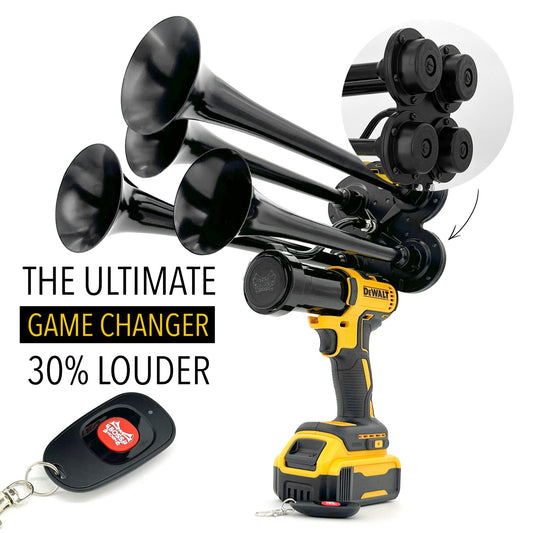Car horns have been a standard feature of automobiles since the early 1900s, when they were introduced as a safety measure to alert pedestrians and other drivers of a vehicle's presence. As technology has advanced, car horns have become louder and more powerful, capable of being heard from greater distances. The ability to hear a car horn from a distance can be crucial in avoiding accidents and alerting others to potential dangers on the road.
The sound of a car horn is typically measured in decibels, with the average car horn producing a noise level of around 110 decibels. Studies have shown that a car horn should be audible from at least 200 feet away in order to effectively convey a warning to other drivers and pedestrians. This distance allows for ample time for individuals to react and take appropriate action to avoid a collision or other hazardous situation.
In urban environments with high levels of background noise, such as traffic and construction, car horns may need to be even louder to be heard from a safe distance. Some cities have implemented regulations requiring cars to have horns that can be heard from a minimum of 300 feet away to account for these noisy conditions. These regulations aim to enhance overall safety on the roads by ensuring that drivers can effectively signal their presence and intentions to others.
As car horn technology continues to evolve, manufacturers are exploring ways to make horns even more powerful and reliable. Newer vehicles may be equipped with dual horns or electronic horn systems that can produce a wider range of tones and pitches, increasing the likelihood of being heard from a distance. By investing in these advanced horn systems, drivers can help ensure that they are able to effectively communicate with others on the road and prevent potential accidents.
What is the optimal distance for a car horn to be audible?
When driving, the sound of a car horn is a crucial safety feature that alerts other drivers and pedestrians of potential hazards or emergencies. The optimal distance for a car horn to be heard can vary depending on various factors such as the surrounding noise level, weather conditions, and the type of horn being used. In this article, we will explore the ideal distance for a car horn to be heard clearly and the importance of ensuring its proper functionality for overall road safety.
The loudness of a car horn plays a crucial role in determining how far away it can be heard. The distance at which a car horn can be heard depends on various factors such as the type of horn, the surrounding environment, and the presence of other sounds. In general, a car horn should be heard from at least 200 feet away to ensure that other drivers and pedestrians are alerted to the presence of the vehicle.
Factors affecting the distance a car horn can be heard include the type of horn installed in the vehicle. For example, a standard car horn typically has a loudness level of around 100-110 decibels, which can be heard from a distance of up to 200 feet. On the other hand, larger vehicles such as trucks may have air horns that can produce sound levels of up to 120 decibels, allowing them to be heard from up to 500 feet away.
The surrounding environment also plays a significant role in determining how far away a car horn can be heard. In urban areas with high levels of ambient noise, such as traffic, construction, and sirens, the distance at which a car horn can be heard may be significantly reduced. In contrast, in rural areas with lower levels of ambient noise, a car horn may be heard from a greater distance.
It is important for drivers to ensure that their car horn is in good working condition and is loud enough to be heard from a safe distance. Regular maintenance and inspection of the horn can help prevent accidents and ensure the safety of both the driver and other road users.
In conclusion, a car horn should ideally be heard from at least 200 feet away to effectively alert others to the presence of the vehicle. However, factors such as the type of horn, the surrounding environment, and the presence of other sounds can influence the distance at which a car horn can be heard. Drivers should prioritize the safety of themselves and others by ensuring that their car horn is in good working condition and has a sufficient loudness level.
Statistics:
- The average loudness level of a standard car horn is around 100-110 decibels.
- Larger vehicles such as trucks may have air horns that can produce sound levels of up to 120 decibels.
- A car horn should ideally be heard from at least 200 feet away to ensure safety on the road.
https://youtube.com/watch?v=eHiQ-ZXflwg
**1. What factors determine how far away a car horn can be heard?**
The distance at which a car horn can be heard depends on various factors that affect the sound's propagation and reception.
- The volume or intensity of the sound produced by the horn will significantly influence how far it can travel.
- Environmental conditions, such as the presence of obstacles or terrain features, can also affect sound transmission.
- The frequency of the sound emitted by the horn may impact how far it carries, as higher frequencies tend to attenuate more quickly than lower frequencies.
**2. How does the design of the car horn impact its reach?**
The design of a car horn plays a crucial role in determining how far its sound can travel.
- The shape and construction of the horn can affect the directionality and focus of the sound waves, influencing their reach.
- The quality of the materials used in the horn's construction can impact its efficiency in producing and transmitting sound waves.
- The placement of the horn on the vehicle also influences how effectively its sound can be heard at a distance.
**3. Can weather conditions affect the range of a car horn?**
Weather conditions can have a significant impact on the range at which a car horn can be heard.
- Factors such as wind speed and direction can either enhance or impede the transmission of sound waves from the horn.
- Atmospheric conditions, such as temperature and humidity, can also influence the propagation of sound and its reach.
- Extreme weather events, such as heavy rain or snow, may dampen the horn's sound and reduce its effective range.
**4. How does traffic noise affect the distance at which a car horn is audible?**
The presence of traffic noise can diminish the distance at which a car horn can be heard.
- Background noise from other vehicles and urban activities can compete with the sound of a car horn, reducing its perceived volume and reach.
- High levels of ambient noise can mask the horn's signal, making it less effective in communicating with other drivers or pedestrians.
- In noisy environments, such as busy city streets or highways, the range of a car horn may be limited by the surrounding acoustic clutter.
**5. Are there any regulations governing the sound range of car horns?**
Regulations regarding the sound range of car horns may vary by region or jurisdiction.
- Some areas have specific guidelines on the maximum volume or decibel level allowed for car horns to prevent excessive noise pollution.
- Certain countries may also mandate the use of specific horn designs or technologies to ensure a standardized level of sound transmission.
- Drivers are typically advised to use their horns responsibly and only when necessary, keeping in mind the potential impact of excessive noise on other road users.
Conclusion
In conclusion, a car horn should ideally be heard only once when it is no more than 200 feet away. This distance allows for the necessary warning to be communicated effectively without causing unnecessary noise pollution. It is important for drivers to be mindful of their surroundings and use their horns sparingly to ensure the safety and well-being of themselves and others on the road. By following these guidelines, drivers can help create a more harmonious and respectful driving environment for everyone.














